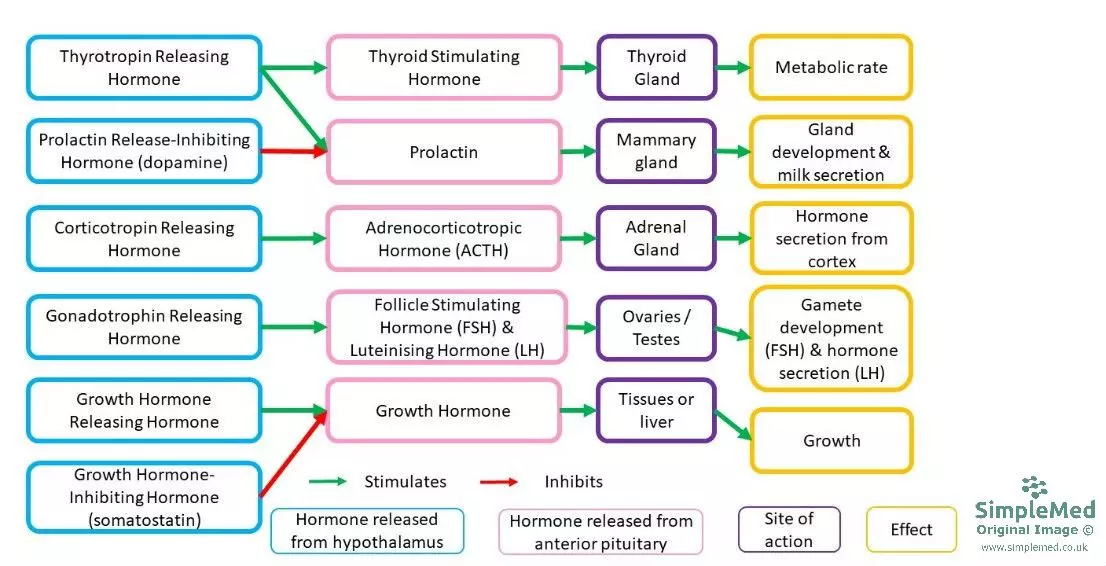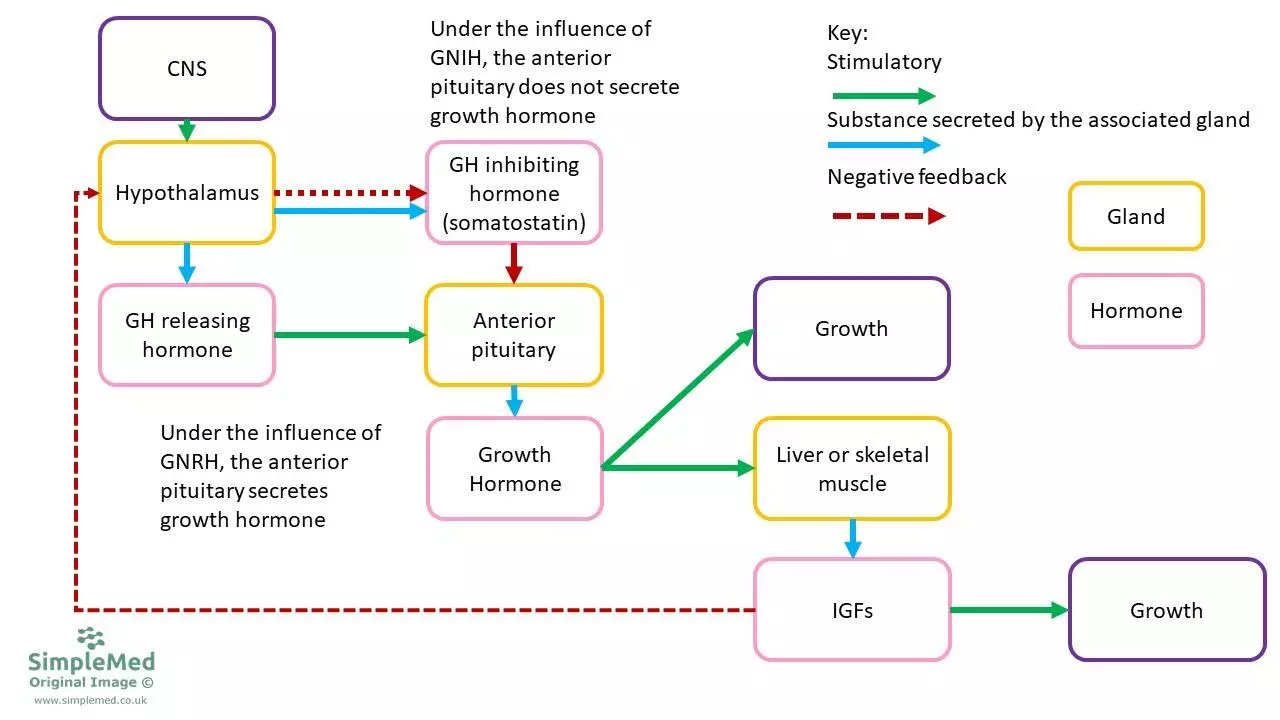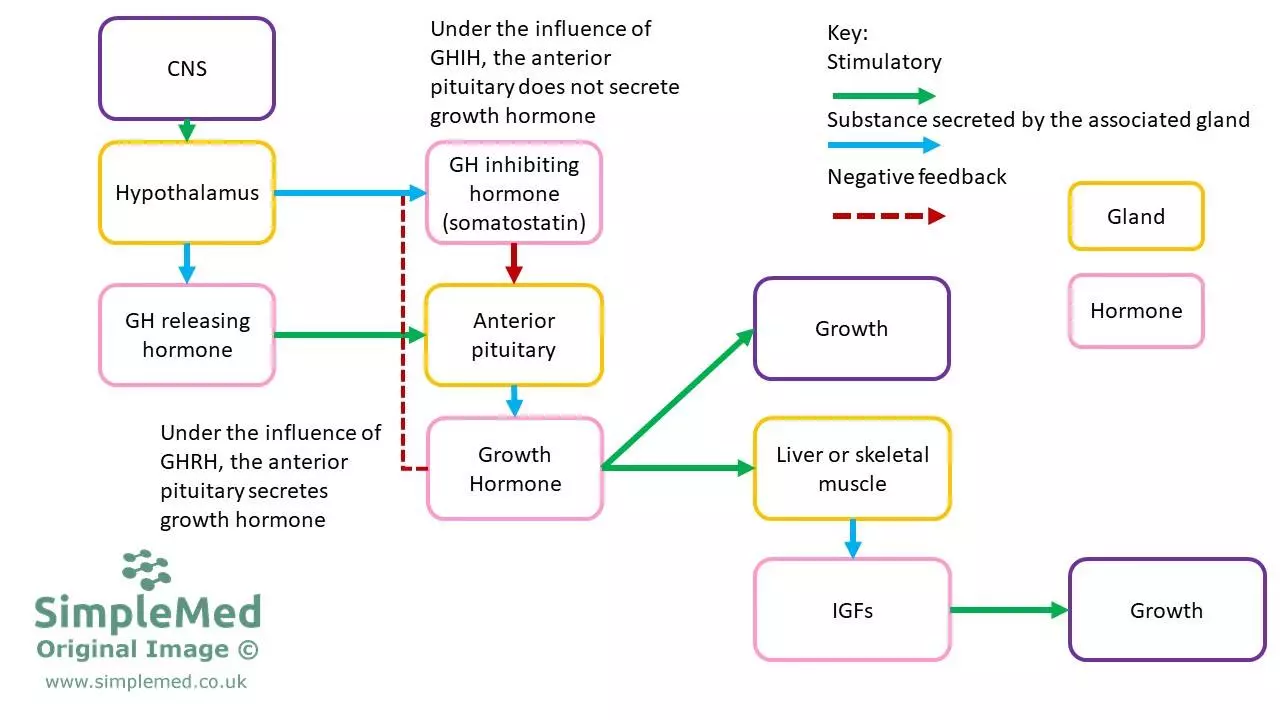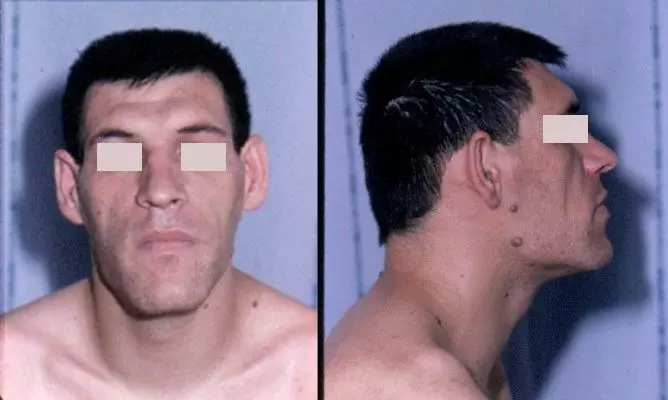Next Lesson - Pituitary Disorders
Abstract
- The hypothalamus and pituitary gland form a complex functional unit that serves as the major link between the endocrine and nervous systems.
- The posterior pituitary gland is responsible for the secretion of oxytocin and anti-diuretic hormone.
- The hypothalamus releases six tropic hormones which act on the anterior pituitary.
- The anterior pituitary is responsible for the release of a variety of different hormones, dependent on the hormonal signals it receives from the hypothalamus.
- Growth hormone is a peptide hormone, responsible for growth regulation through direct and indirect methods.
- Growth hormone can be regulated by a variety of methods, two of which are through short-loop and long-loop negative feedback.
Core
The hypothalamus and pituitary gland form a complex functional unit, called the hypothalamic-pituitary axis, that serves as the major link between the endocrine and nervous systems. The pituitary gland can be found within the sella turcica (a socket of bone on the base of the skull, meaning ‘turkish saddle’), with the hypothalamus sitting above it. The hypothalamic-pituitary axis has a large number of capillaries in them, called the hypophyseal portal system, which makes it easy for the hormones to be released directly into the bloodstream and allow communication between the hypothalamus and the pituitary gland. The functions of the hypothalamic-pituitary axis include body growth, reproduction, adrenal gland function, water homeostasis, lactation, thyroid gland function, and puberty.
The pituitary gland consists of two parts: the anterior and posterior pituitary glands. The posterior pituitary gland itself is not technically a gland as it does not produce the hormones that it secretes. The hormones secreted by the posterior pituitary are produced by the hypothalamus.
The pituitary glands have distinct embryological origins. The anterior arises from an evagination of oral ectoderm (primitive gut tissue), and the posterior from neuroectoderm (primitive brain tissue).
The posterior pituitary gland is physically connected to the hypothalamus by the pituitary stalk, which begins embryologically as the infundibulum. The posterior pituitary gland secretes two hormones:
- Oxytocin, involved in the milk let-down reflexduring breastfeeding and uterine contractions during birth.
- Antidiuretic hormone (ADH), which is involved in the re-uptake of waterin the nephron of the kidney.
Both of these hormones are produced by neurosecretory cells in the supraoptic and paraventricular nuclei of the hypothalamus. They are then transported down nerve cell axons to the posterior pituitary, where they are stored. They are released from the posterior pituitary into the general circulation when stimulated. The hormones then travel round the circulation to act at distant targets.
The other hormones synthesised in the hypothalamus are transported down axons and stored in the median eminence (a part of the hypothalamus) before being released into the hypophyseal portal system. When released, these hormones stimulate target endocrine cells in the anterior pituitary to release their hormones.
Endocrine cells of the anterior pituitary secrete a variety of hormones into the bloodstream to act on distant target cells. Anterior pituitary hormones can also affect the cell it was released from and neighbouring cells (meaning the anterior pituitary also has autocrine and paracrine functions).
Tropic hormones are hormones that affect the release of secondary hormones in the target tissue, meaning that all the hormones produced in the hypothalamus are trophic hormones. There are six tropic hormones produced in the hypothalamus that have direct effects on the release of anterior pituitary hormones. The pathways to produce hypothalamic and anterior pituitary hormones are often regulated by negative feedback, and many of these will be discussed in other articles in the endocrinology series.

Diagram: Shows the different hormones released from the hypothalamus and which hormones are released from the pituitary glands in response
SimpleMed original by Jenny Hubball
Whilst the image above gives a good overview of the hormones released from the hypothalamus, anterior pituitary, and their effect, there are a couple of additional pieces of information to note:
- Prolactinis mainly controlled by its inhibition and not its stimulation. The stimulatory effect of thyrotropin releasing hormone is very minor. This means that pregnancy and breastfeeding are the only times when prolactin is NOT inhibited.
- Prolactin Release-Inhibiting Hormone, or dopamine, can act as both a hormoneand a neurotransmitter.
- Thyroid stimulating hormonecauses release of the thyroid hormones T3 and T4, and these are the hormones which have the metabolic functions.
- A good example of a hormone secreted by the anterior pituitary is growth hormone, which will now be discussed in further detail below.
The main function of growth hormone is somatic growth (growth of the body). Growth hormone is the main regulator of growth postnatally (after birth), but growth is also influenced by factors such as genetics, nutrition, and environment. There are also some other hormones that influence growth other than growth hormone, these are listed below.

Table: Shows the hormones other than growth hormone that have an effect on somatic growth
SimpleMed original by Jenny Hubball
Growth hormone is a 191 amino acid protein hormone that has a signal peptide which must be cleaved before proper folding of the hormone can occur. Its growth-promoting effects are mainly exerted indirectly via insulin-like growth factors (IGFs), but it can also have direct effects on the body. In response to growth hormone, skeletal muscle and liver cells can produce and secrete IGFs.
Growth hormone receptor are tyrosine kinase receptors. Once growth hormone has attached to the receptors on the cells, it causes the cells to activate Janus Kinases, causing them to be phosphorylated. This in turn causes the activation of signalling pathways causing transcription factor activation and IGF production.
There are two IGFs that exist in mammals:
- IGF1 - major growth factor in adults.
- IGF2 - mainly involved in fetal growth.
Binding proteins modulate the availability of IGFs, and their action can be endocrine, autocrine, and paracrine. They act through IGF receptors to modulate hypertrophy, hyperplasia, increase in protein synthesis rate, and increase in lipolysis in adipose tissue.
Growth hormone and IGFs have different functions in children and adults:

Table: Shows the effects of growth hormone on the body
SimpleMed original by Jenny Hubball
The secretion of growth hormone is regulated by growth hormone releasing hormone (GHRH) and growth hormone inhibiting hormone (GHIH or somatostatin) released from the hypothalamus. These two hormones are in turn regulated by the central nervous system, which controls secretion through inputs to the hypothalamus. It can also be regulated by short loop and long loop negative feedback.
- Long Loop: The production of IGFs inhibits the release of GHRH from the hypothalamus, and stimulates the release of GHIH from the hypothalamus, inhibiting the release of growth hormone from the anterior pituitary.


Diagram: Shows the long negative feedback loop controlling growth hormone release
SimpleMed original by Jenny Hubball
- Short Loop: The production of growth hormone stimulates the release of GHIH release from the hypothalamus, inhibiting the release of growth hormone from the anterior pituitary.

Diagram: Shows the short negative feedback loop controlling growth hormone release
SimpleMed original by Jenny Hubball
The regulation of growth hormone through the central nervous system is dependent on many different actions, which can themselves either increase or decrease growth hormone secretion. These factors can be seen below.

Table: Shows the different factors that affect the secretion of growth hormone
SimpleMed original by Jenny Hubball
Pituitary dwarfism is a condition caused by growth hormone deficiency in childhood. It is a proportionate type of dwarfism. This condition responds to growth hormone therapy. Signs of pituitary dwarfism include:
- Growth rate slower than expected for age.
- Height below the 3rd percentile on standard growth charts.
- No/delayed sexual development during teenage years.
Gigantism is a condition caused by growth hormone excess in childhood, where the excess hormone encourages growth of the whole body. It is extremely rare and is usually caused by a pituitary adenoma.
Acromegaly is a condition caused by growth hormone excess in adulthood. In this condition, the patient has large extremities (e.g. hands, feet, lower jaw), as the epiphyseal growth plates of the bones have already fused, so growth hormone cannot increase somatic height. Acromegaly is also usually caused by a pituitary adenoma.

Diagram: Shows the facial features of acromegaly
Creative commons source by Philippe Chanson and Sylvie Salenave [CC BY-SA 3.0 (https://creativecommons.org/licenses/by-sa/3.0)]
Reviewed by: Dr. Thomas Burnell
Edited by: Dr. Maddie Swannack
- 15459

